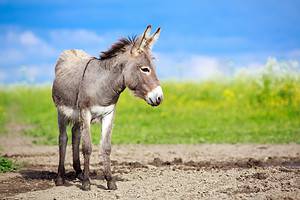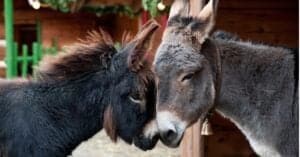Donkeys are domesticated members of the Equidae family. They’re well known for their harsh braying noises and stubborn nature. They diverged from their wild cousin, the African wild ass, about 5,000 years ago in Egypt. Today, there are many varieties of donkey in use as pack animals, pets, and means of transportation all over the world. But no matter the size, or purpose, of these jacks (male donkeys) and jennies (female donkeys), they all have the same type of teeth.
Here, we’ll learn more about the specific dental structure of donkeys, what kind of teeth they have, and why they ‘smile’. Then, we’ll take a look at some of the common dental problems donkeys run into, and what you should look out for if you own a donkey. Finally, we’ll explore how veterinary specialists treat dental ailments in these domestic asses.
Donkey Milk teeth
Most donkeys gestate for about a year (anywhere from 10-14 months). They almost always have only one foal, which is born toothless. The donkey’s first sustenance comes from its mother’s milk, but it only takes the foal a few weeks to start growing its first set of ‘baby’ teeth. As they grow, these teeth are replaced, one by one, by their permanent dentition.
How Many Teeth Do Donkeys Have?
By the time they’re five years old, donkeys have all of their adult teeth, though they don’t start replacing the baby teeth until they’re about 2.5 years old. Adult donkeys have 40 teeth; 12 incisors, four canines, 12 premolars (up to 16 if wolf teeth are present), and 12 molars.
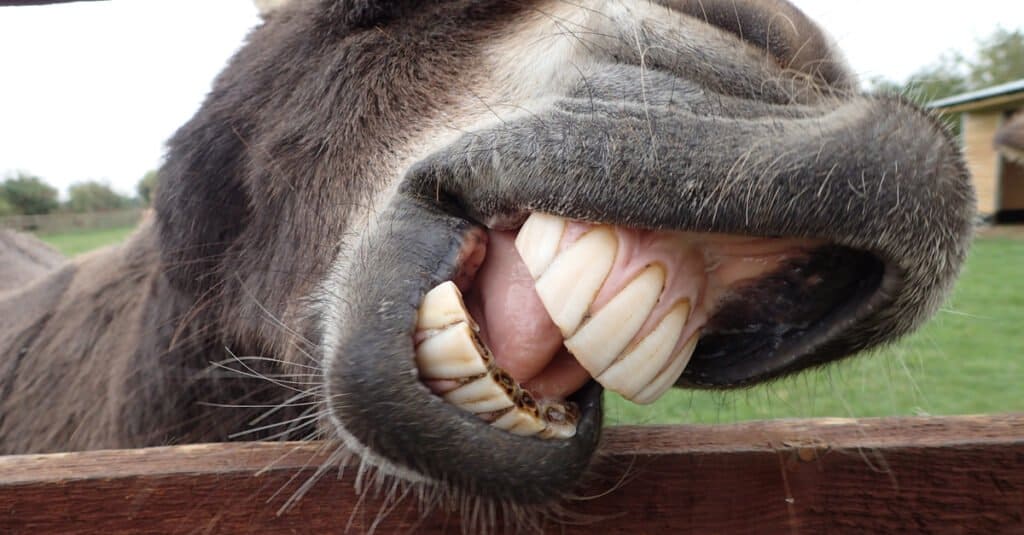
Donkeys have 40 teeth; 12 incisors, 4 canines, 12 premolars, and 12 molars
©alan payne/Shutterstock.com
True Teeth
Donkey’s have two types of tooth in their mouth; true teeth, and ever-erupting teeth. The true teeth include the incisors and canines. The characteristics of true teeth are that they have three distinct parts; root, neck, and crown. These teeth erupt once, and then don’t continue growing. Once they wear away, they’re gone for good.
Incisors
The first teeth in the donkey’s mouth, and the most visible, are the incisors. These teeth are flat and blocky looking, like overgrown human incisors. Donkey’s have 12 total incisors; six on the top and six on the bottom. They’re used primarily to pull vegetation from shrubs, trees, and branches. Then, they chop this food up into smaller pieces, before the tongue pulls it back into the mouth for additional chewing.
Canines
Donkeys have four small canine teeth; one in each quadrant of their jaw. Functionally, they don’t do much. They’re located just behind the incisors. A large gap called a diastema separates the canines from the next teeth in the donkey’s jaw; the premolars.
Ever-Erupting Teeth
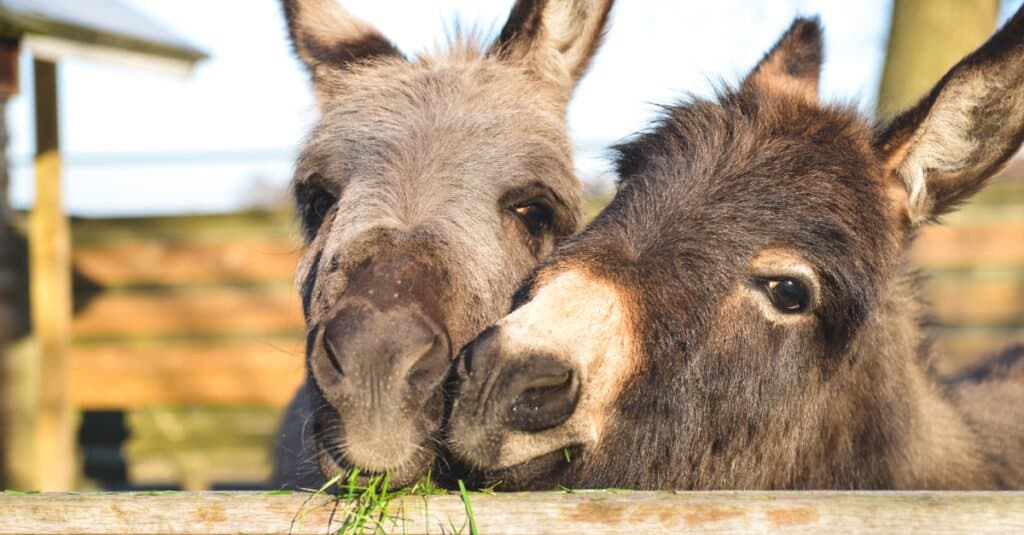
Donkeys have been known to sweat due to heat exposure and intravenous adrenaline infusion.
©babeaudufraing/Shutterstock.com
Donkeys have two types of teeth–front teeth, like the canines and incisors, and cheek teeth, like the premolars and molars. Donkey cheek teeth are categorized as ever-erupting, rather than true teeth. They don’t have true roots like the incisors and canines, and they have tall crowns with high ridges for chewing.
As donkeys age, these cheek teeth erupt further and further from the jaw; this offsets the normal use-wear that grinds them down over time. As the cheek teeth erupt, bone grows and fills the empty sockets in the jaw. Cheek teeth don’t have defined necks or roots, like true teeth–this is part of how they can continue to ‘grow’ throughout the donkey’s life.
Premolars and Molars
Donkeys normally have 24 total cheek teeth; 12 premolars and 12 molars. But, some donkeys (more males than females) are born with extra premolars called ‘wolf teeth’. These wolf teeth are small, and are located in front of the normal first premolar. They can sometimes cause issues, such as cuts to the tongue or cheeks, and are often extracted.
The rest of the donkey’s cheek teeth are used for chewing and masticating the tough foods (like hay and grass) that donkeys thrive on. Their high crowns and irregular ridges grind against each other, and make short work of anything the donkey decides to chew on.
Donkey With Big Teeth: Why Do Donkeys Smile?
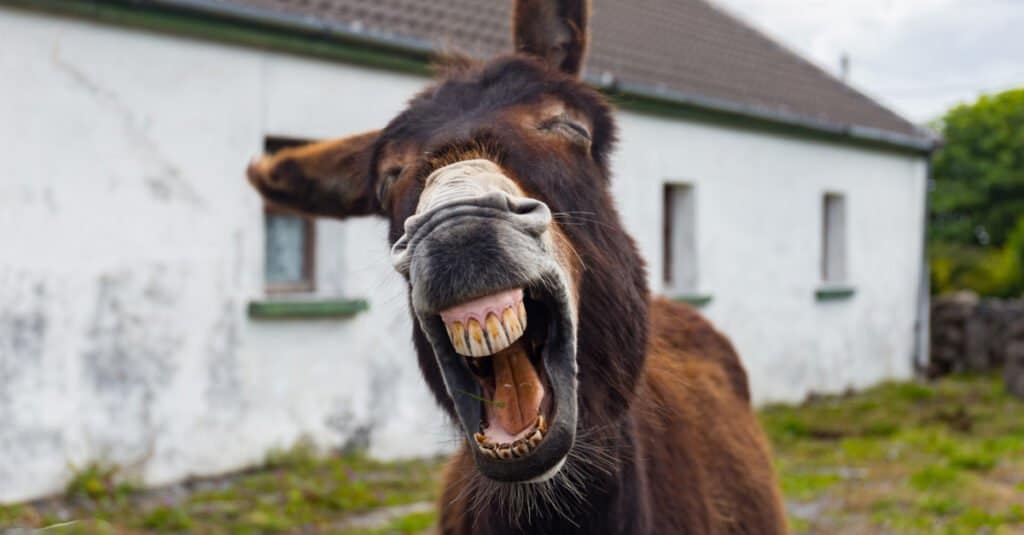
Donkeys smile when they smell something interesting to get the smell straight to their olfactory organs
©ElDuderino/Shutterstock.com
If you’ve ever been around a donkey, you know that they’re prone to pulling their upper lip up and displaying their teeth in an expression that looks similar to a human smile. Donkeys however, aren’t doing it because they’re happy or excited; they’re doing it to better smell something interesting. Donkeys smile because of something called a flehmen response–a behavior they exhibit when they catch wind of something interesting. Lifting their upper lip helps them deliver the smell directly to their smelling organs, and airs out their front teeth too.
Dental Problems
Dental ailments are some of the most common medical issues in donkeys. They may break, or even lose teeth in the course of their life. Donkeys are stoic, and often won’t show any sign of something being wrong. But, owners should watch out for weight loss, difficulty chewing, excessive drooling or nasal discharge, and bad breath. Any one of these signs could be an indication that your donkey is having a bad tooth day.
Overgrowth
One additional problem donkeys may encounter with their cheek teeth is overgrowth. This happens when either the donkey is missing a tooth, or the teeth aren’t occluding against each other properly. Overgrown teeth can develop high, sharp ridges that may cut the tongue or cheek and interfere with eating.
If you suspect that your donkey has something wrong in its mouth, call a veterinarian, or better yet, an equine dental technician (EDT). It’s best not to attempt to treat the animal on your own, as sedatives and special equipment are often required to look into the mouths of these stubborn beasts of burden.
The photo featured at the top of this post is © ElDuderino/Shutterstock.com
Thank you for reading! Have some feedback for us? Contact the AZ Animals editorial team.



